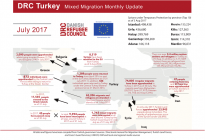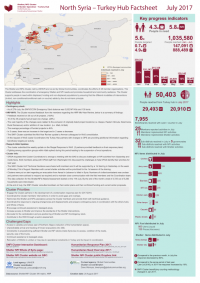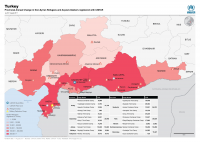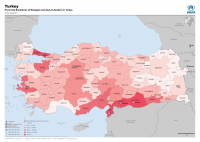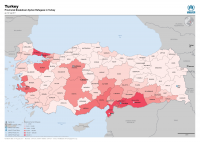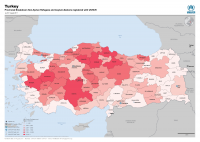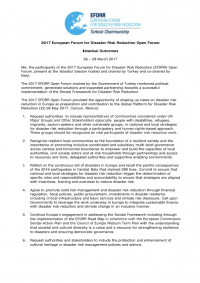Turkey
OngoingOverview
Key Content
- UNICEF Turkey Humanitarian Situation Report #11, July 2017
- UNHCR Inter-Agency Coordination Turkey Protection Sector - Q2 | January - June 2017
Appeals & Funding
- Turkey: 3RP Regional Refugee & Resilience Plan 2016-2017

- 3RP Regional Strategic Overview 2017-2018

UNHCR Regional Refugee and Migrant Response Plan for Europe (Jan to Dec 2017)
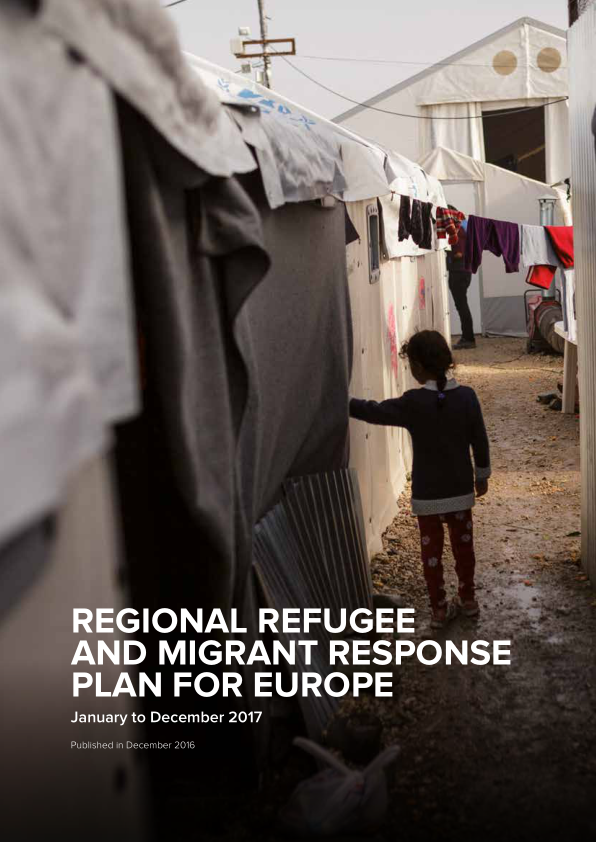
Humanitarian Action for Children 2017-2018: Syrian refugees and other affected populations in Egypt, Iraq, Jordan, Lebanon and Turkey


- Country-based Pooled Fund: 2016
- Syria Crisis Guide to Giving
- European Union Facility for Refugees in Turkey
Useful Links
Disasters
- Middle East: Cold Wave - Jan 2015
- Syria/Iraq: Polio Outbreak - Oct 2013
- Turkey: Earthquakes - Oct 2011
- Turkey: Landslide - Aug 2010
- Turkey: Earthquakes - Mar 2010
- Europe: Cold Wave - Dec 2009
- Turkey: Floods - Sep 2009
- Influenza A (H1N1) Pandemic - Apr 2009
- Turkey: Floods - Nov 2006
- Turkey: Bingol Earthquake - Mar 2005
Izmir – Last weekend (26-27/08), 11 teams of young migrant, refugee and Turkish entrepreneurs presented their innovative business ideas to IOM, the UN Migration Agency, in the hope of securing a grant. Under its entrepreneurship training and grants project, IOM is working to build business skills among young people, helping make their business ideas a reality.
Highlights
Syria: During the reporting period, IOM teams provided 43,887 beneficiaries in Al-Hassakeh, Rural Damascus, Lattakia, Homs, Tartous, and Damascus with non-food items, health assistance, and shelter support.
Turkey: In July, IOM began a partnership with the Turkish Red Crescent to expand the opening hours of six Turkish Red Crescent community centres providing Syrian refugees with Turkish language courses during the weekday evenings and weekends.
The Shelter and NFIs Cluster, led by UNHCR and co-led by Global Communities, coordinates the efforts of 48 member organizations. The Cluster addresses the coordination of emergency Shelter and NFI needs and promotes household and community resilience. The Cluster supports people in need within displaced, hosting and non-displaced populations by ensuring that the different modalities of interventions (in-kind, non-conditional/conditional cash or voucher) abide by the do-not-harm principle.
Highlights
During 2017, food sector partners have reached approximately 2.67 million individuals with food assistance through cash, voucher or in kind modality. 3,300 have individuals received food and agricultural livelihoods support while 8,700 individuals have been supported for improved nutritional practices.
These dashboards reflect selected regional sectoral indicators on the humanitarian and resilience responses of more than 240 partners involved in the 3RP Inter-Agency Appeal in Egypt, Iraq, Jordan, Lebanon and Turkey. Achievements are regionally aggregated and cumulative from the start of 2017 and targets are based on full funding of the 3RP 2017 and an expected population of 4.7 million refugees by end-2017.
As the Syria crisis entered its seventh year in March, the number of Syrian refugees in the region passed the five million mark. There are now almost 3 million Syrian refugees registered refugees in Turkey, over 1 million in Lebanon, some 661,000 in Jordan, almost 237,000 in Iraq and above 120,000 in Egypt, indicating the generosity of countries across the region.
As at the end of June, some 901,450 Syrian children across the region are enrolled in formal education in schools located in camps and host communities. Additionally, around 51,343 Syrian children are enrolled in informal education.
By the end of June 2017, over 1.2 million primary health care consultations were provided, representing over 33 per cent of the 2017 overall target, and over 88,000 were referred to secondary or tertiary health care. Furthermore, 496,000 children have been immunized and 26,000 health care staff have been trained.
3RP partners’ priority regarding the Shelter Sector continues to be the provision of adequate, affordable and sustainable housing options for refugees living in host communities. For refugees in camps, 3RP partners focus on rehabilitation efforts to improve the infrastructure of the camp and upgrade shelters in order to contribute to sustainable living. During 2017, 12,444 households in camps have received assistance for shelter and shelter upgrades, while outside of camps 17,552 households received assistance for shelter and shelter upgrades.
So far in 2017, over 996,300 individuals have benefited from access to adequate quantity of safe water through improved longerterm water systems. Approximately 327,400 people have gained access to appropriate sanitation facilities and services, and over 505,300 people have access to adequate quantity of safe water through temporary provision.
Since the start of 2017, Livelihoods Partners assisted 16,133 refugees and host community members with short-term and/or long-term employment opportunities and 54,975 youth and adults in increasing their employability through job training, internships, job placement and language courses. In addition, 19,144 host community members and the refugees have participated in community based activities to promote social cohesion.
The basic needs sector aims to strengthen the capacities and resilience of local governance through development of simplified service delivery standards, provision of required equipment and skills development. Until June 2017, 185,000 households have received core relief items in kind, which is just over 83 per cent of the targeted population. Approximately 319,000 households have received unconditional, sector specific or emergency cash assistance and over 203,600 households received seasonal support through cash or in kind assistance.
Overview
In 2017, between January and June, 99,865 refugees and migrants crossed the Mediterranean Sea from North Africa and Turkey. Most crossed the central Mediterranean from Libya to Italy. The top five countries of origin during this period were Nigeria, Côte d’Ivoire, Bangladesh, Guinea (Conakry) and The Gambia. In the first six months of 2017, 74% of arrivals were men, 15% children, and 11% women.
Highlights
Approximately 72,000 Syrian and other refugee children received a conditional cash transfer for attending school regularly in May and June – a 28.5 per cent increase over the previous period. The payment also included, for the first time, children attending temporary education centres (TECs).
More than 2,600 pre-school age refugee children enrolled in a new, UNICEFsupported summer language programme to support their entry into the Turkish primary school system.
Highlights Q2/2017
1,035 voluntary returns under AVRR
76 families among those returning
55% of returnees (573 individuals) are between the age 18—26
54% of returnees (564 individuals) were assisted with tailored reintegration packages
86% of those assisted (486 individuals) opted for self-employment/small business projects
Herat and Balkh received the highest number of returns under AVRR (122 respectively 94 individuals)
The Forum has engaged a broad range of stakeholders including Governments, the UN, parliamentarians, mayors, intergovernmental organizations, scientific and academic institutions, private businesses, NGOs, community based organizations and others. The multi-stakeholder engagement strengthens our approach as we consider all perspectives to identify, and avoid to the extent possible, the creation of new risks, as called for by the Sendai Framework.

